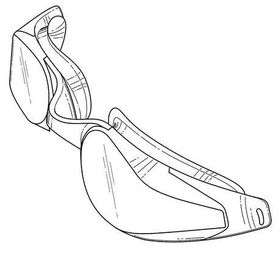 Design patents can be valuable tools to prevent your competitors from copying your innovations and producing counterfeit products or knock-offs. As part of your intellectual property strategy, it might be advisable to protect your innovation with both design and utility patents. What is a design patent? As a lifelong swimmer, I will use this design patent obtained by Roka Sports, Inc. as an illustration of how to successfully use design and utility patent protection. This design patent issued in January 2018 for “Swimming Goggles with Retroscopic Lens.” As you can see from the example, the design patent includes one claim: “The ornamental design for swimming goggles with retroscopic lens, as shown and described.” The scope of the patent is defined by the design illustrated in the 7 figures within the patent. Design patents cover the appearance of an article. This means a design patent can cover the configuration or shape of an article, the surface ornamentation applied to an article, or the combination of configuration and surface ornamentation. To be protectable, the design must be a definite, preconceived thing that is capable of reproduction and not merely the chance result of a method. As I write this blog, over 2,800 design patents have been granted so far in 2018. Some examples of these design patents include: toys, lighting fixtures, faucets, golf clubs, automotive components (wheels, headlights, muffler, dashboards, etc.), cameras, display screens, cases for electronic devices (such as cell phones), tires, audio equipment (including microphones and speakers), jewelry, containers (such as bottles for beverages, floral containers, etc.), tools, and shoes. How is a design patent different from a utility patent? In contrast to the above, utility patents protect the way an article works. Keeping with the swimming goggles example, here is a recent Roka Sports utility patent. As you can see, the subject is swimming goggles with a retroscopic lens, but the description is much more detailed regarding how the goggles are made and used, and there are many detailed claims. The scope of patent protection is defined by the 32 claims of the patent. This Roka Sports example illustrates how you can use both design and utility patents to protect your inventions, so long as your innovation has both functional and ornamental characteristics. Some other main differences between design and utility patents include:
When considering how to protect your innovations, consider whether a design patent might be useful for you. Design patents can provide significant protection along with utility patents, trademark, copyright and trade secret.
0 Comments
Your comment will be posted after it is approved.
Leave a Reply. |
AuthorKarrie Weaver practices intellectual property, trademark, patent, and trade secret law. Archives
February 2021
Categories |
612.386.0565
Copyright 2021. Weaver Legal and Consulting LLC. | All rights reserved.
Website by RyTech, LLC
Copyright 2021. Weaver Legal and Consulting LLC. | All rights reserved.
Website by RyTech, LLC

 RSS Feed
RSS Feed